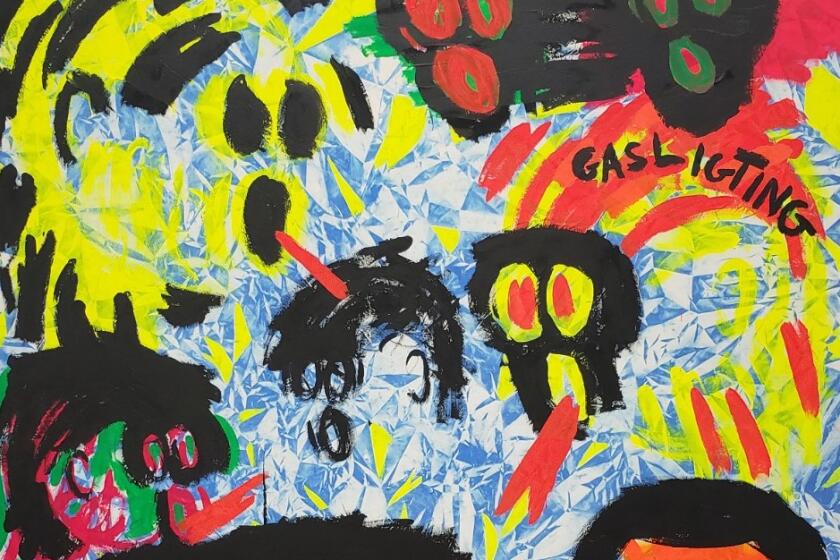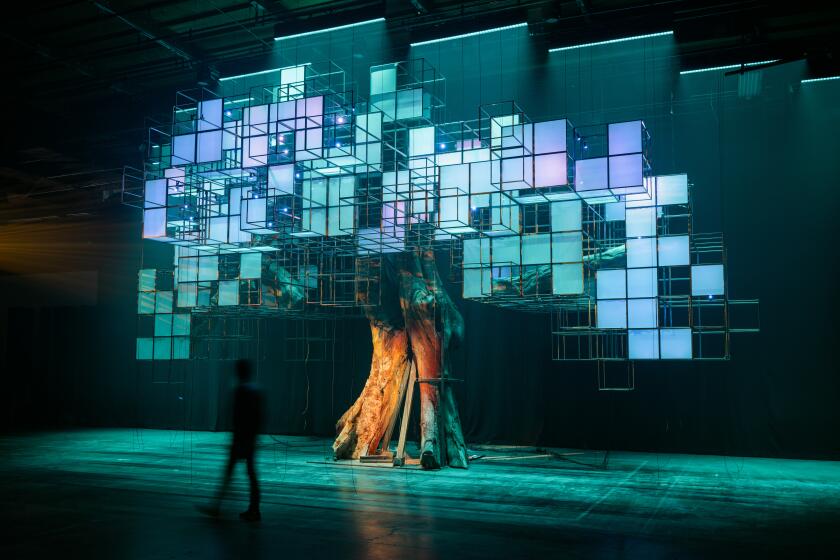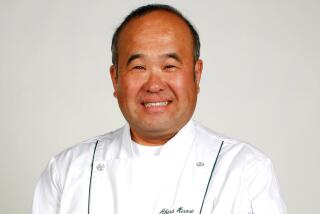Review: In Glenn Kaino’s VR installation, transformational loss ushers in new forms of beauty
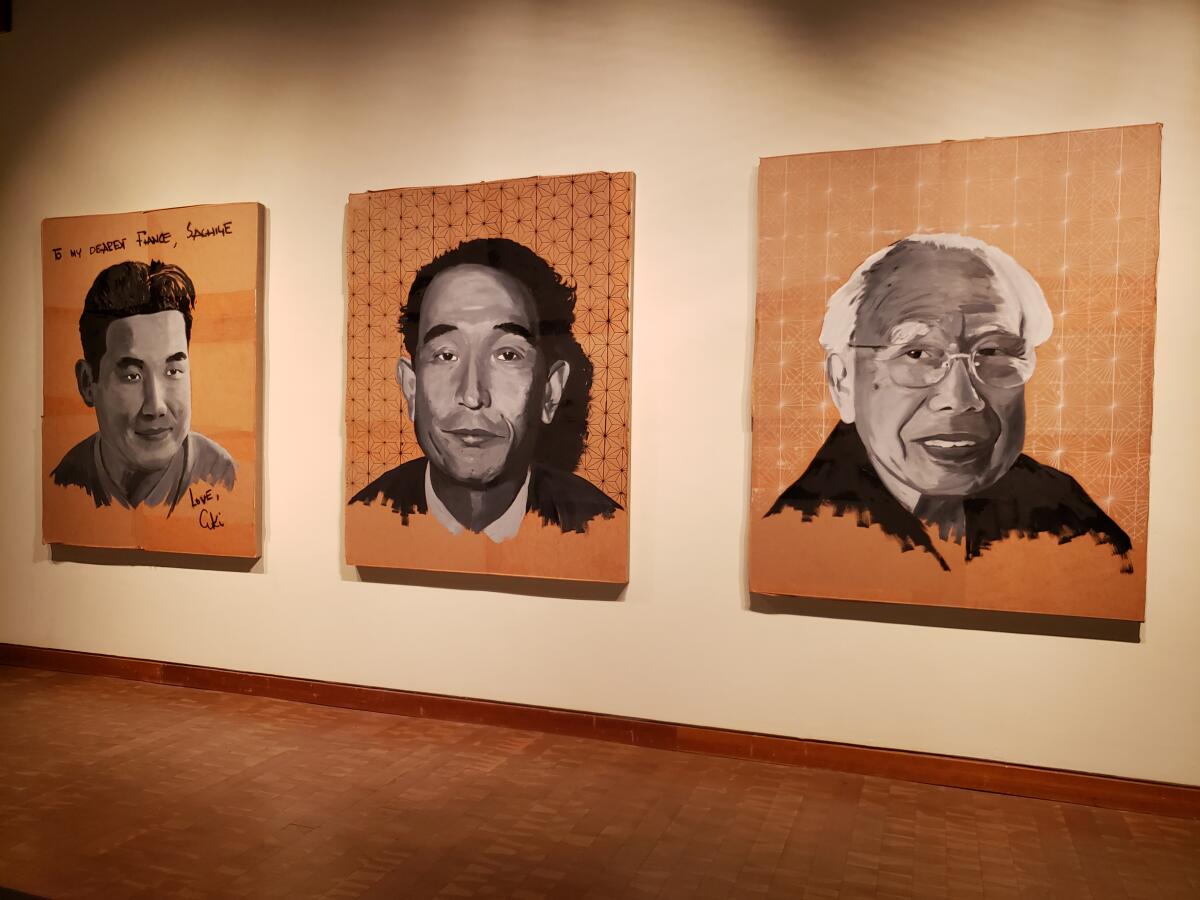
- Share via
“Aki’s Market,” a new, multilayered installation by Los Angeles-based artist Glenn Kaino, erects a captivating theater of dreams. By turns savvy, surprising and sweet, the provocative motif is the construction of a personal image of a deeply important place — one where the artist has never actually been.
The installation has virtual reality as its centerpiece, a technology that can easily feel like a stunt. But not here. Kaino deftly weaves it together with traditional painting and sculpture in unexpectedly challenging ways.
Its subject is “Aki’s Market,” a convenience store in East L.A. opened in 1956 by a grandfather he never knew; it closed in 1970 after the patriarch’s death. Kaino, whose middle name, Akira, is his grandfather’s, was born in 1972. His knowledge of the store is assembled from family lore, a few artifacts and cultural frames of reference.
So is the installation. It unfolds through four spaces at the Japanese American National Museum in Little Tokyo. Marvelously orchestrated, the work evolves from an anonymous abstraction into an increasingly personal narrative. A viewer’s engagement is surreptitiously enticed.
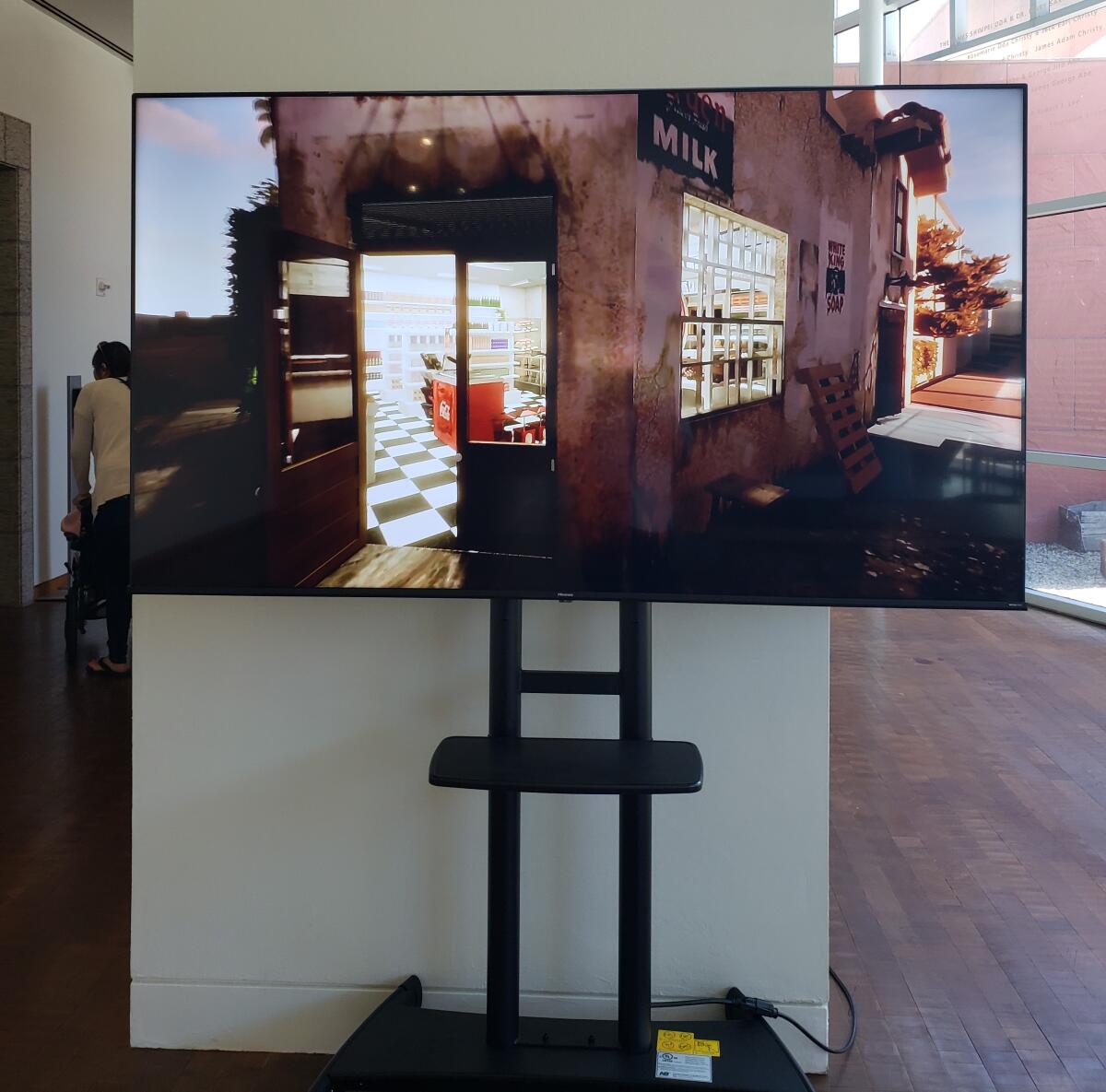
In the museum lobby, an ordinary flat-screen TV mounted on an easel runs a two-dimensional video walk-through of a three-dimensional virtual reality construction, which shows an ordinary, unexceptional corner market. The visual journey starts out on a sunny neighborhood sidewalk, the shop’s front door facing an intersection of two residential streets. It progresses inside to wander around shelves of merchandise — canned goods, snacks, magazines, a pan dulce case, hula hoops — as if looking around in search of something.
Nothing is found, and the loop begins again. The same video, now a VR projection, is shown in the exhibition’s final room, a small theater. The show itself is a searching loop.
Just inside the first gallery, a different, more old-fashioned picture is encountered. A small, square, perfectly ordinary black-and-white snapshot mounted atop a pedestal shows Aki Shiraishi posed in front of stacked canned goods. Undated, it’s apparently the only real-time fragment of visual information about the actual place on which Kaino could rely to fabricate his much more elaborate interior scene.
A small magnifying glass clipped to a stand lets you peer closely at the photograph, but without revealing much useful detail. As a dreamy, rhythmic score wafts through the sound system in the large gallery, the clinical, not especially helpful magnifying mechanism underscores a feeling of thwarted intimacy.
Over on a side wall, the photograph’s black-and-white pictorial motif repeats again in three large-scale oil paintings on butcher paper, surely elaborated from old photographs. The three portraits depict Aki at three stages of life — as a youth, a middle-aged man and an elder. (The first carries an inscription: “To my dearest fiancé, Sachiye.”) But the anonymous, lens-based old machinery used for the pedestal-bound snapshot has been replaced.
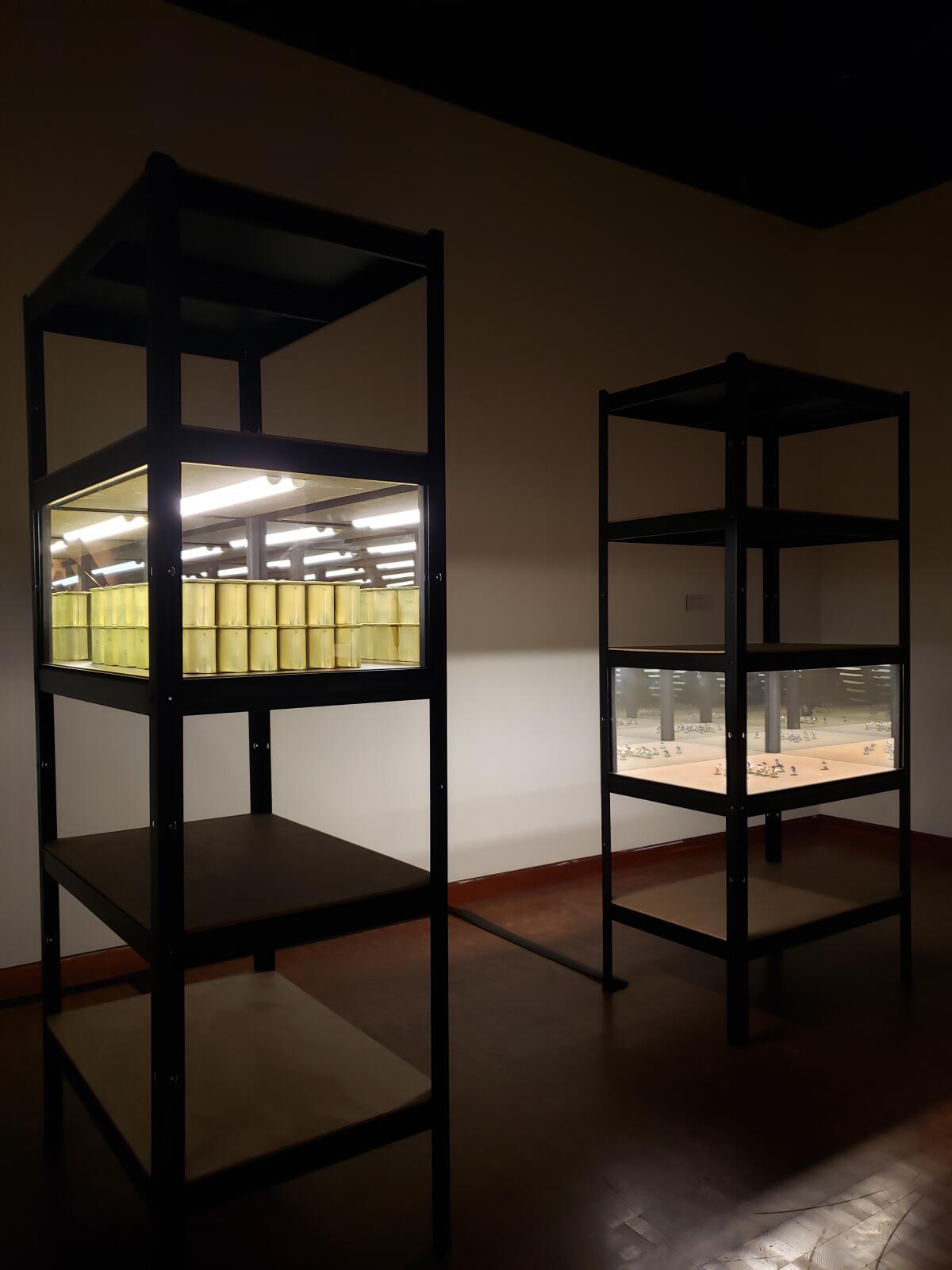
Now, the oil paint’s loose brushwork, which exposes the artist’s hand, and the triptych’s butcher paper, which references what would be usefully found in a shop, quietly introduce elements of a personal relationship. At the rear of the gallery, two sculptures of multitiered shelving, each glassed-in and brightly illuminated from within by fluorescent lights, expand on the connection.
One, “Taken Inventory (Keep Stock),” features a shelf filled with stacks of yellow tin cans. Without labels, their rectangular shapes suggest canned luncheon meats crossed with a treasury’s gold bars. Mirrored walls inside the shelf’s corner visually extend the luminous rows of stock into an image of labor-intensive infinity. A sense of disappearance — of “inventory taken” — is also not without a hint of theft.
The other sculpture, “Taken Inventory (Endless Field),” has a shelf covered in fine sand. On it, two teams of tiny toy football players face off. The white team has 11 players — a full set — but the blue team has only nine. Its mirrored corner spins the unequal game into twirling infinity.
With the specter of fascism all around us again, the bellowing confrontation in Judith Bernstein’s work, a combination of wit and outrage, is nothing if not timely.
Aki was an East L.A. high school football star with aspirations for Occidental College, where he’d received a scholarship, and then, perhaps, a pro career. Catastrophe intervened. In the spring of 1942, a few months after Imperial Japan attacked Pearl Harbor, he was rounded up with tens of thousands of other innocent Americans of Japanese ancestry and sent to a remote prison camp — in his case, Wyoming’s Heart Mountain.
While the sculpture’s white team is intact, the two missing blue players, rather than just one, suggest Aki was not alone in suffering cruel displacement and imprisonment. Details like these expand a story of personal trauma into one of larger social damage.
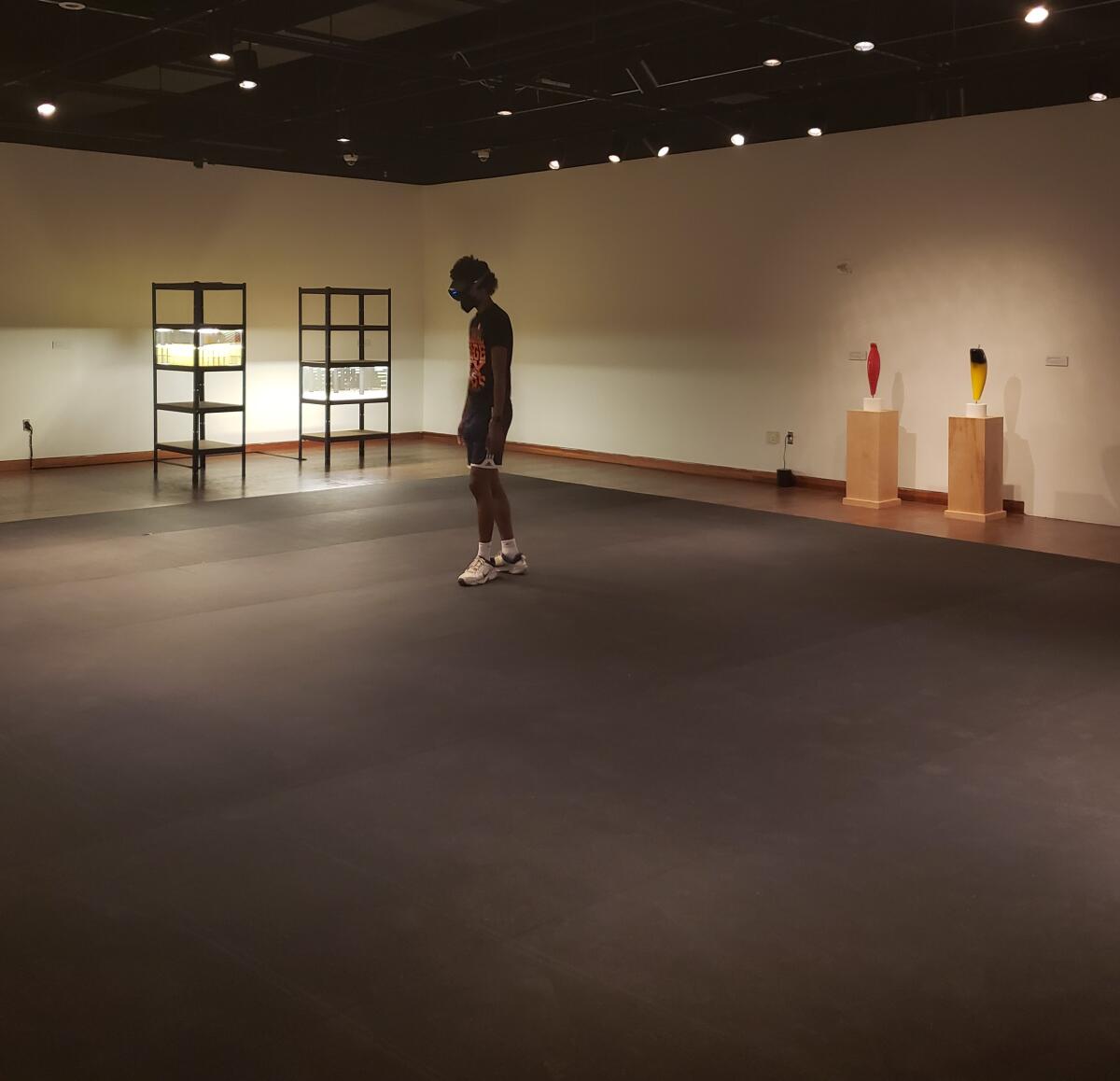
The inclusion of a trio of sculptures from earlier in Kaino’s steadily developing career is likewise suggestive of the ways in which evolving personal history inflects an artistic narrative. Two from 1997-98 are giant, pedestal-bound fishing lures — Aki was apparently an avid fisherman — their sleek, almost abstract, lozenge-like forms recalling classic Modernist sculptures from Brancusi’s studio. (“Bird in Space” becomes fish out of water.) Nearby, protruding from a wall, the stars and stripes in a bleached-white 2021 American flag are darkly stained.
These seven paintings and sculptures hug the gallery perimeter, leaving the center of the room a wide-open arena. Think “playing field.” There, a gallery attendant fits visitors, one at a time, with virtual reality goggles. (A schedule of when the VR experience is available, which differs from the show’s regular hours, is at the museum’s website.) The blank space fills with intangible imagery of the fictionalized convenience store;s interior. You grope your way through the phantom market, sometimes to the amused observation of waiting visitors.
The two-dimensional picture seen on the entry flat screen now pops into a vaporous three-dimensional illusion. The most startling feature is not anything inside the store — not those ordinary hula hoops, or that typical pan dulce. Instead, as you pass by shop windows and doors opening to the outside world, you glimpse Kaino’s paintings of his grandfather in the surrounding gallery and his sculptures denoting the forebear’s life. Fiction and authenticity conflate and separate. A tremor ripples between virtual and artistic reality.
Glenn Kaino’s magical forest inside a 28,000-square-foot L.A. space is an immersive journey that includes animatronic trees, fire illusions and interactive sound sculptures.
In the next room, unencumbered by the VR goggles, a faceoff between two works on opposite walls provides perhaps the most poignant moment. (They’re separated by a makeshift motorcycle cobbled together from found objects — the installation’s single puzzling object.) One is by Kaino’s grandmother, Aki’s widow Sachiye. A tight Japanese punch embroidery (called Bunka shishu) depicts an elegant, elaborate Kabuki figure.
Kaino, employing the same model of embroidery kit — a kind of paint-by-numbers that uses thread instead of oil paint — follows her lead. But he didn’t stretch the support, and he let the colorful embroidery threads hang loose, cascading down the unfinished front surface like a purifying waterfall.
His traditional Kabuki figure is unraveling in time and space, along with the once very popular Bunka shishu kit itself. Image and object dissolve and are reconstructed, not unlike Kaino’s VR market. As an image of transformational loss ushering in new forms of beauty, the pair enchants.

The exhibition has no catalog, unfortunately, although there is a good brochure. Leaving the show, I decided to drive over to the East L.A. intersection a few blocks from City Terrace Park, where Aki’s Market once did neighborly business. Spotting it was easy, the distinctive roof line and corner-facing door the giveaways. But it has reverted back into a bungalow home. You’d never know.
Or, perhaps I should say that, rather than reverted, it has moved on to another phase of life. The stories now unfolding among the unidentified current inhabitants are anybody’s guess, both virtual and actual.
'Glenn Kaino: Aki’s Market'
Where: Japanese American National Museum, 100 N Central Ave., Little Tokyo
When: Tuesdays, Wednesdays, Fridays–Sundays: 11 a.m.–5 p.m. Thursdays: 12 p.m.–8 p.m. Closed Mondays. Through Jan. 28.
Info: (213) 625-0414, www.janm.org
More to Read
The biggest entertainment stories
Get our big stories about Hollywood, film, television, music, arts, culture and more right in your inbox as soon as they publish.
You may occasionally receive promotional content from the Los Angeles Times.
